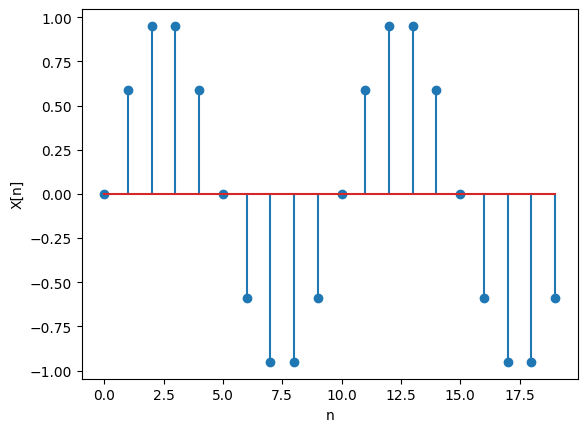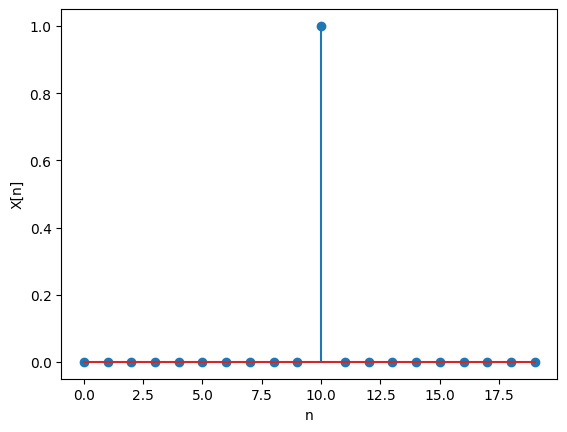Before going on with deicrete signals, let us remember what continuous signals are: Continuous signals are defined on real numbers \(\mathbb{R}\). Notationally they are denoted by small case letters and indexed by curly braces and with a dependent variable $t$, like $x(t)$, $y(t)$. As \(t \in \mathbb{R}\), \(x(2.7)\), \(y(\sqrt{3})\), \(x(\pi)\) are well-defined.
Discrete signals are defined on integers $\mathbb{Z}$. Notationally they are they are denoted by capital letters and indexed by angle braces and with a dependent variable $n$, like $X[n]$, $Y[n]$ etc. As $n \in \mathbb{Z}$, $X[2]$, $Y[-4]$, $X[0]$ are well-defined. But $X[2.7]$, $U[\sqrt{3}]$, $W[\pi]$ are undefined and using such expressions indicates a mistake.
Discrete exponential signals
Exponential discrete signals are defined as follows.
$$\begin{eqnarray}
X[n] = Ae^ {\alpha n}, n \in \mathbb{I}
\end{eqnarray}$$
The python code which will print this discrete signal for $\alpha = -0.1$ is given below.
import matplotlib.pyplot as plt
import numpy as np
n = np.arange(0,0.20,1);
X = np.exp(-0.1*n);
plt.stem(X)
plt.xlabel('n')
plt.ylabel('X[n]')
plt.show()
And, this is the resulting plot:
Discrete sinusoid signals
Exponential sinusoids are defined as
$$\begin{eqnarray}
X[n] = A \sin( {\Omega n + \Omega_0}),
\end{eqnarray}$$
where $n \in \mathbb{I}$ and $\Omega, \omega_0 \in \mathbb{R}$.
A plot for $\Omega = \frac {2\pi}{10}$, $\Omega_0 = 0$ is given below:

Discrete dirac deltas (Kronecker Deltas)
A kronecker delta is the analogue of a dirac delta in discrete domain.
$$\begin{eqnarray}
\delta[n]=
\begin{cases}
&1, \qquad \mathrm{n=0}\\
&0, \qquad \mathrm{otherwise}
\end{cases}
\end{eqnarray}$$
import matplotlib.pyplot as plt
import numpy as np
n = np.arange(-10,10,1);
X = (n==0);
plt.stem(X)
plt.xlabel('n')
plt.ylabel('X[n]')
plt.show()

Discrete unit step
A discrete unit step is described as
$$\begin{eqnarray}
U[n]=
\begin{cases}
&0, \qquad n<0 \\
&1, \qquad 0 \leq n
\end{cases}
\end{eqnarray}$$
Discrete indicator function
A discrete indicator step can be described as
$$\begin{eqnarray}
\chi_{[a,b]}[n]=
\begin{cases}
&1, \qquad a \leq n \leq b \\
& 0, \qquad \mathrm{otherwise}
\end{cases}
\end{eqnarray}$$
